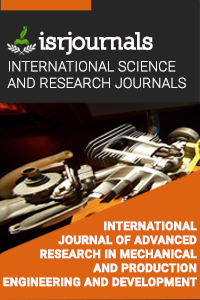bottom ash concrete
K. Nataraj,Dr. G. Mohan Ganesh,A. S. Santhi
Published in International Journal of Advanced Research in Mechanical and Production Engineering and Development
ISSN: 2320-7256 Impact Factor:1.398 Volume:1 Issue:1 Year: 08 June,2013 Pages:6-11

Abstract
This paper about the experimental investigations on the study of bottom ash concrete by replacing river sand with lignite based bottom ash. Bottom ash is a coarser material, which falls into furnace bottom in modern large thermal power plants and constitute about 20% of total ash content of the coal fed in the boilers. Bottom ash, which is rarely used in concrete due to its inactive pozzolanic reaction, improved its quality of concrete. Since fine collection is completely replaced with bottom ash. The effect of mechanical properties on bottom ash has to be studied. This project will give a clear idea of sustainable effect of bottom ash concrete. The strength development for various percentages (0‐ 40%) replacement of cement with fly ash has to be studied at various stages
Kewords
Bottom ash, fly ash, Pozzolanic reaction
Reference
Concrete Technology by M.S. Shetty. P. Aggarwal , Y. Aggarwal, S.M. Gupta: Effect of bottom ash as replacement of fine aggregates in concrete, Asian journal of civil Rafat Siddique*: Effect of fine aggregate replacement with Class F fly ash on the mechanical properties of concrete, Department of Civil Engineering, Thapar Institut Figure 5. Chart of compressive strength against percentage of replacement of cement with fly ash The maximum increase in the compressive strength is found in the specimens as given the above chart. Tensile Strength Cylinder specimens were tested for compression and the average ultimate tensile stress was determined from the failure compressive load. The values of average tensile strength are given in Table 3. Charts are plotted as average tensile strength against percentage fly ash added to concrete is given in Figs.6. Table 3 show the percentage increase in the tensile strength of bottom ash concrete over the compressive strength of concrete with replacement of cement with fly ash. We find tensile strength using cylinder splitting tension test. The splitting strength gives 5 to 12% higher value then the direct tensile strength. Calculation of tensile strength is given by C= P/πLD. Where P is compressive load on cylinder, L is length of cylinder and D is the diameter of cylinder. Tensile Strength Figure 6. Chart of tensile strength against percentage of replacement of cement with fly ash The maximum increase in the tensile strength is found in the specimens are given above. ∗ Engineering and Technology, Deemed University, Patiala 147004, India Received 28 February 2002; accepted 16 September 2002. Sivasundram,V. and Malhotra, V.M., High performance high volume fly ash concrete, Indian Concrete Journal, Nov (2004) 13‐ 2. Naik, T.R. and Ramme, B.W., High strength concrete containing large quantities of fly ash, ACI Materials Journal, March‐ April (1989) 111‐ 116. IS:12269‐ 1987.Specifications for 53 grade Portland cement, Bureau of Indian Standards, New Delhi, India. 2-2009. Recommended guidelines for concrete mix design, Bureau of Indian Standards, New Delhi, India.

